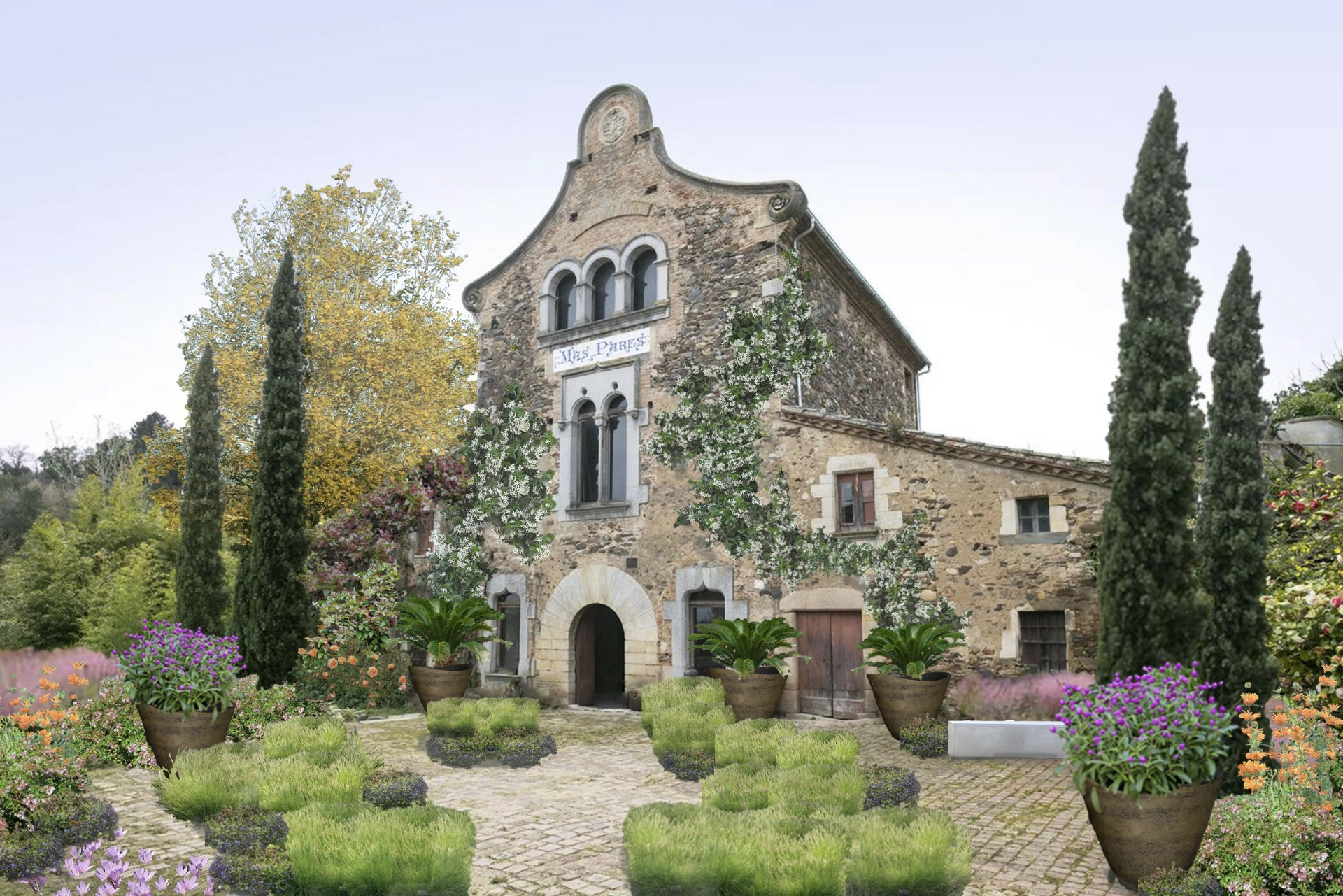Autumn Garden Secrets, with Renowned Landscape Designer Tanya Wilson
Tanya Wilson: “A garden feels alive and magical when it’s rich in wildlife.
Gardens don’t just bloom in spring. Autumn has its own poetry: trees, shrubs, and perennials shift into hues of red, gold, and purple, while ceramics, water features, and sculptural accents add depth and texture. To help us uncover the secrets of creating a truly spectacular fall garden, we spoke with Tanya Wilson, founder of Studio Terraforma. Based in Mallorca, her practice specializes in landscape design that nurtures an emotional connection with nature. Here, Tanya shares her expert vision for preparing, planting, and styling a garden that thrives through the autumn season.
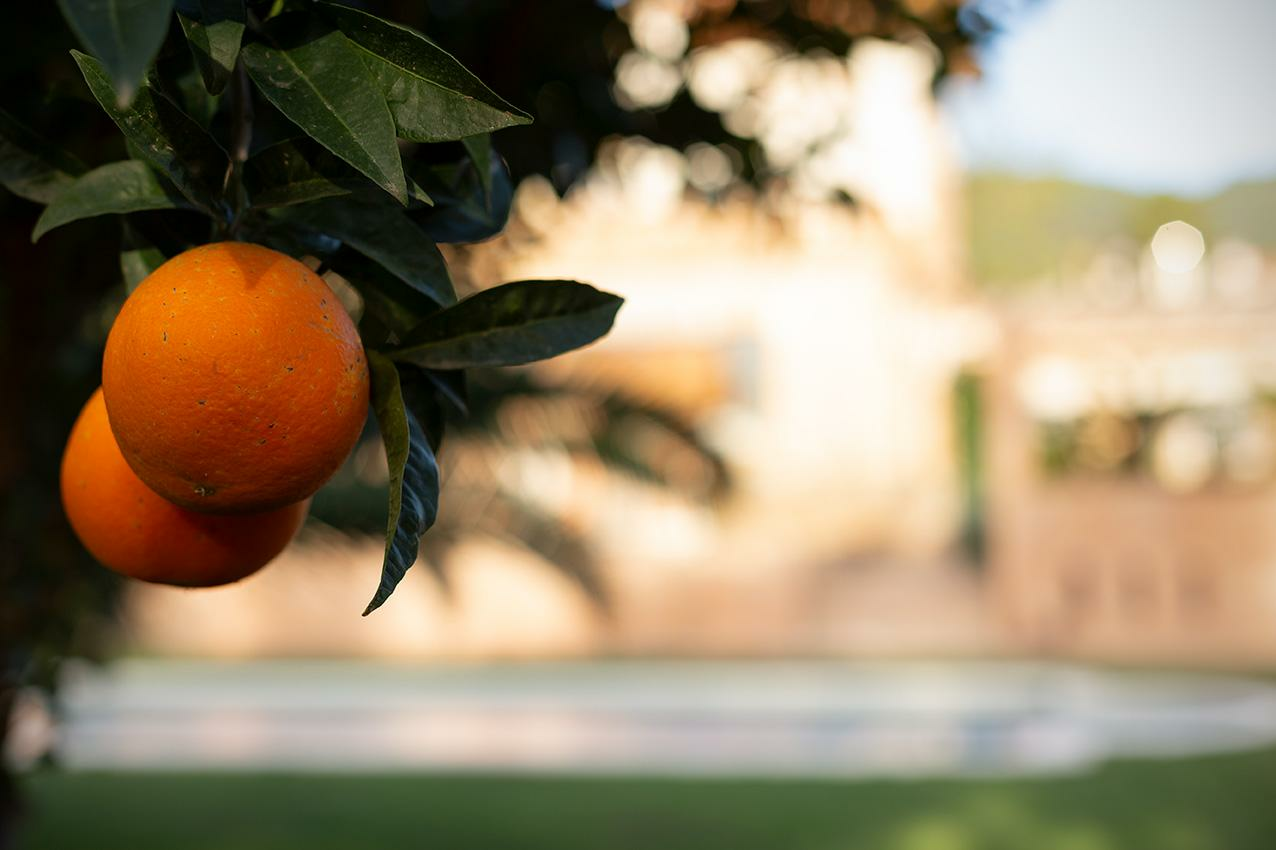
What characteristics should an autumn garden have to look spectacular?
As some trees and plants begin to loose their leaves in the Fall, it’s important to have an evergreen trees and shrubs that give the garden its structural bones. To that base, a layering of deciduous trees that provide fall color such as sycamores, fall blooming perennials, ornamental grasses for texture and movement, climbers and flowering ground covers and bulbs that provide large swaths of a flowering carpet. Wonderful accessory features include ceramic pots. They are great for showing architectural plants or seasonal color like a massing of Gomphrena ‘Purple Dots’.
A garden should be a feast for the nose as well as the eyes, so perhaps think about planting Jasmine (Jazmín) (some varieties bloom into autumn), fall blooming roses such as Louise Clements, or Osmanthus (Olivo fragante) which has a incredible apricot-like scent. Also, think about wildlife. A garden feels alive and magical when it's rich in wildlife. Berry-bearing shrubs like pyracantha, cotoneaster, or hawthorn provide a vital food source for birds. Late nectar flowers, such as Salvia greggii, Lantana, and Leonotis will keep bees and butterflies visiting long into the season. Finally, a water feature will delight with its sound while also attracting wildlife.
Is it possible to achieve a garden full of color during this season?
Autumn light in Spain is lower and sharper, which highlights shapes and textures beautifully. Autumn colors come in many forms, such as the fiery reds of a Virginia creeper (la parra virgen) covering a wall, shades of orange and yellows found in changing leaves of a Sycamore. Then there are the beautiful golden yellows of plants like Rudbeckia or Mahonia ‘Soft Caress’ or tones of chartreuse of ornamental grass like Autumn Moor grass or Lomandra. Also available are deep purples like Autumn asters (Áster) salvias, lavender, rosemary and Gomphrena which is great for pots (and also nice as a cut flower). White Tulbaghia, jasmine, gaura or plumbago can add a luminous touch in the evening.
Autumn light in Spain is softer and crisper than in many other countries, beautifully highlighting shapes and textures.
Tanya Wilson
What recommendations would you give for preparing a garden for fall?
The scorching summer has stressed plants and depleted the soil, so fall's milder temperatures and (hopefully) increased rainfall provide the perfect window to get your garden ready for winter and ensure a spectacular spring. Autumn is the best time for planting as it takes advantage of rain and allows roots to adjust in time for Spring growth while offering a good start before the summer heat sets in. Fall is also the time for planting Spring bulbs. It’s also an important time of cut backs, pruning, feeding and mulching to provide a protective layer for winter. In terms of garden maintenance, If your garden is important to you, invest as much as you can in its upkeep to ensure your garden endures over time.
What types of plants can be grown during this season?
Once again there are regional differences to take into consideration. Plant spring-flowering bulbs such as tulips, daffodils, hyacinths, and irises before the first frost. Plant perennials, ornamental grasses, shrubs, and trees: The warm soil encourages strong root growth without the heat stress of summer. This gives plants a huge head start for the following year, perfect for rosemary, lavender, sage, fruit trees, and native shrubs. It’s also time to sow a vegetable garden. Leafy greens, root vegetables, brassicas, garlic and onions.
What care does a garden lawn require during this time?
If a lawn is necessary, autumn is important for lawn care in Spain. The intense summer heat stresses the grass, and autumn provides the ideal conditions—warm soil, cooler air, and (usually) more moisture—for it to recover, strengthen its roots, and prepare for winter dormancy or to look good through the milder months. It is important to take into consideration regional and local differences when following a autumn care regimen. Steps typically include: Scarification (“Escarificado”), Aeration (“Airado”), Top-Dressing (“Recebo”), Over-seeding (“Resiembra”), Fertilizing (“Abonado”), Watering (“Riego”), Mowing (“Corte”). If you have a large lawn, consider transforming some or all of it to an interesting flowering meadow or a low growing tapestry lawn to create a more dynamic garden that requires less water.
What decorative elements should not be missing from an autumn garden?
One of the easiest ways to make a dramatic change is by investing in some nice pottery. Carefully selected for shape, material and color, they can soften architecture and add style. They can be nice focal points and also provide opportunities for creating new plant combinations or seasonal displays. Also high on the list is a bench or seating element, especially if it is sculptural or a unique custom element. Tucked into an intimate corner or set along an important site line, it can invite interaction or define a destination. A water feature has the ability to create calmness and change moods. It brings the dynamic of sound and movement, adds a feeling of refinement, attracts wildlife and creates interesting reflections with the light and sky. Finally, good garden lighting by a professional designer will extend your outdoor living and create depth to your garden from inside your home. Warm, layered lighting creates a special atmosphere while also highlighting focal points in your garden.
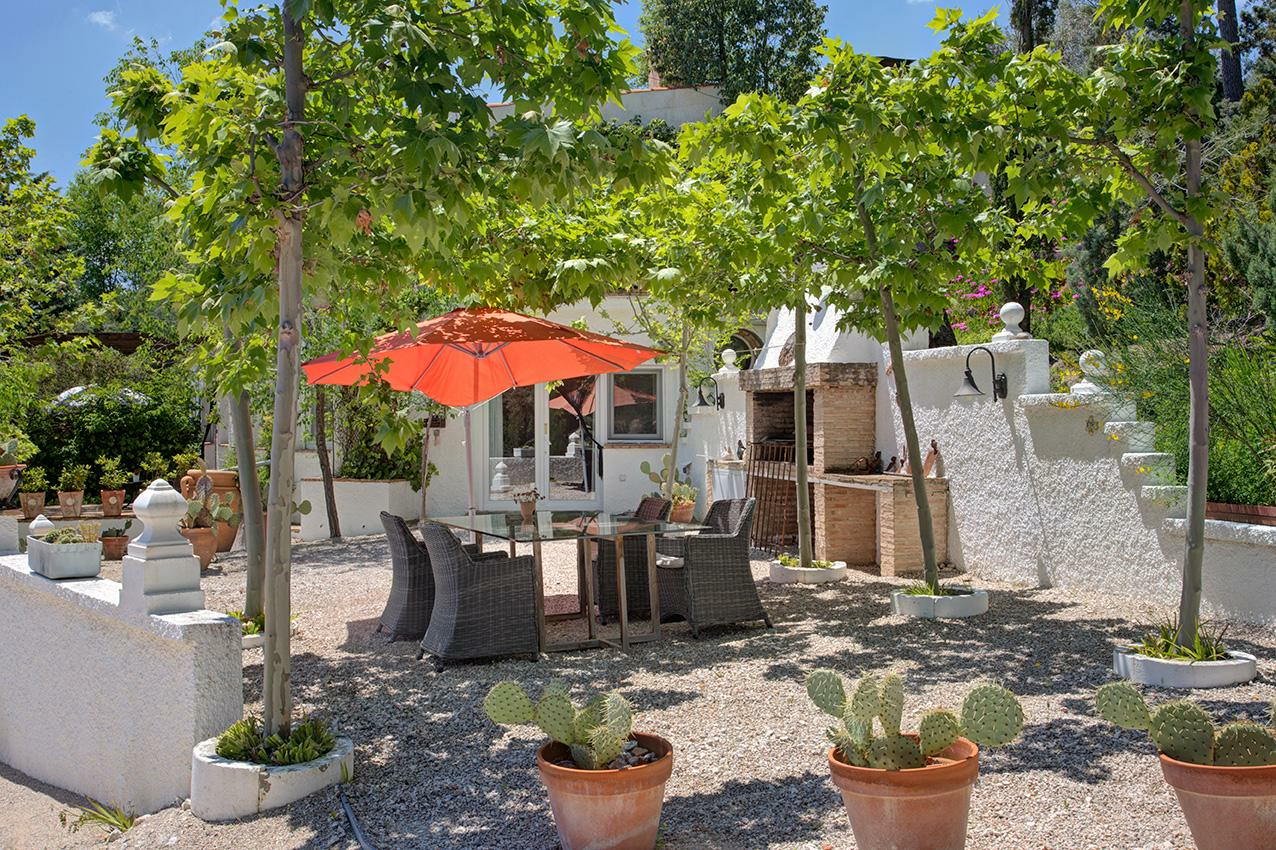
How would you design the fall garden for one of the properties we have for sale? Choose the one you like best...
Mas Parés is a historic property has loads of character with the scale of its central architecture, curves and arches. Located in Girona, there are many suitable plant choices for this entrance garden.
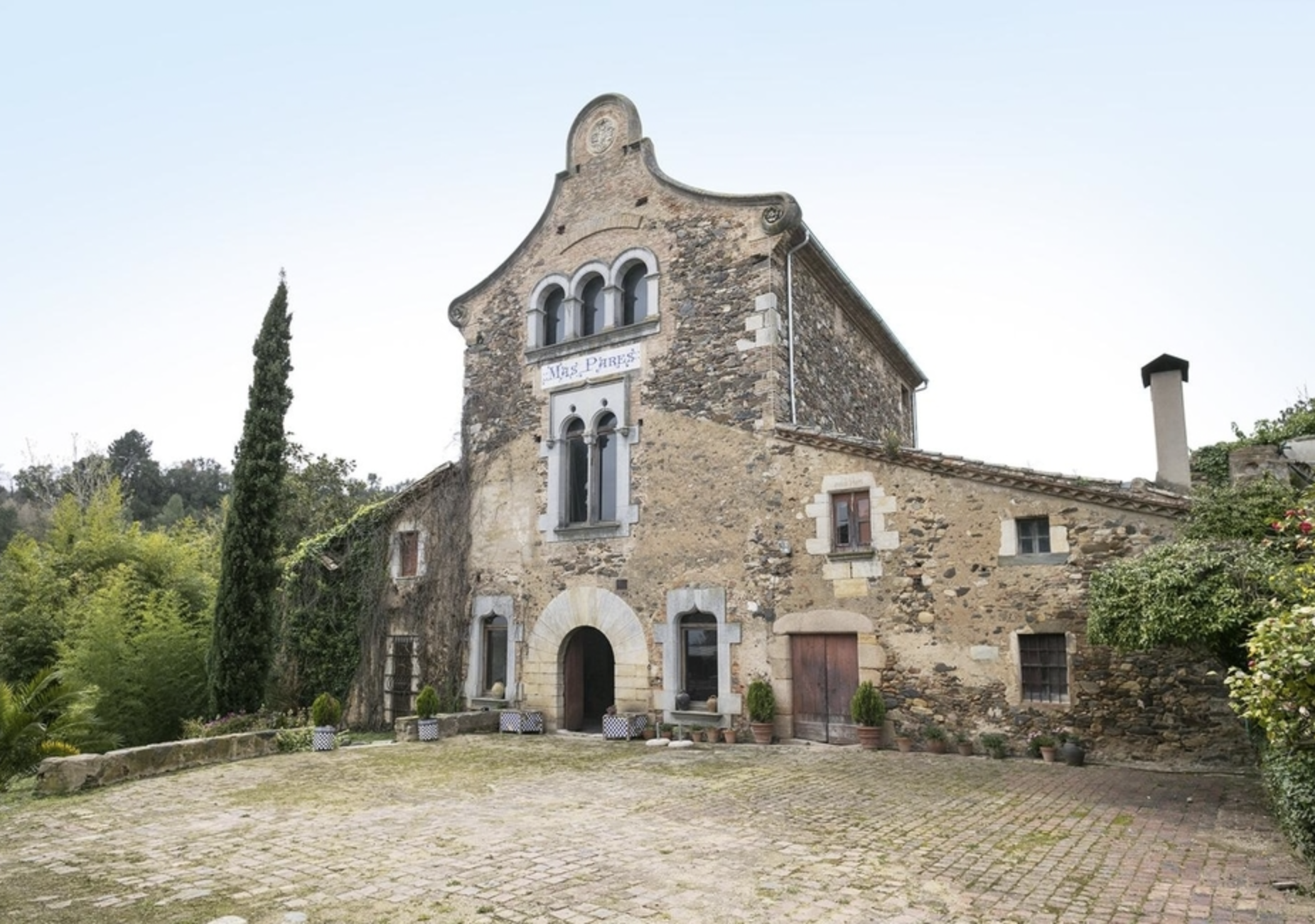
I added more cypress trees to form pairs, allowing their stature to balance the scale of the tall central facade. Their dark green shape echos the pair of Moorish influenced windows (design tip: group cypress trees instead of creating a line so they look more natural).
For the fall garden, I like the idea of adding a large shade tree such as Platanus hispanica to the left balancing the architecture’s scale as well as for it’s interesting bark once the leaves have fallen. I also immediately thought about softening the large amount of paving by interspersing groups of Sesleria autumnalis Autumn Moor grass and Ceratostigma plumbaginoides to create a layered effect. Its soft, subtle and low. The Ceratostigma has small blue flowers, its leaves later turning burgundy. This coincides with the existing Virginia creeper vine at the left corner turning to shades of burgundy and red in the fall.
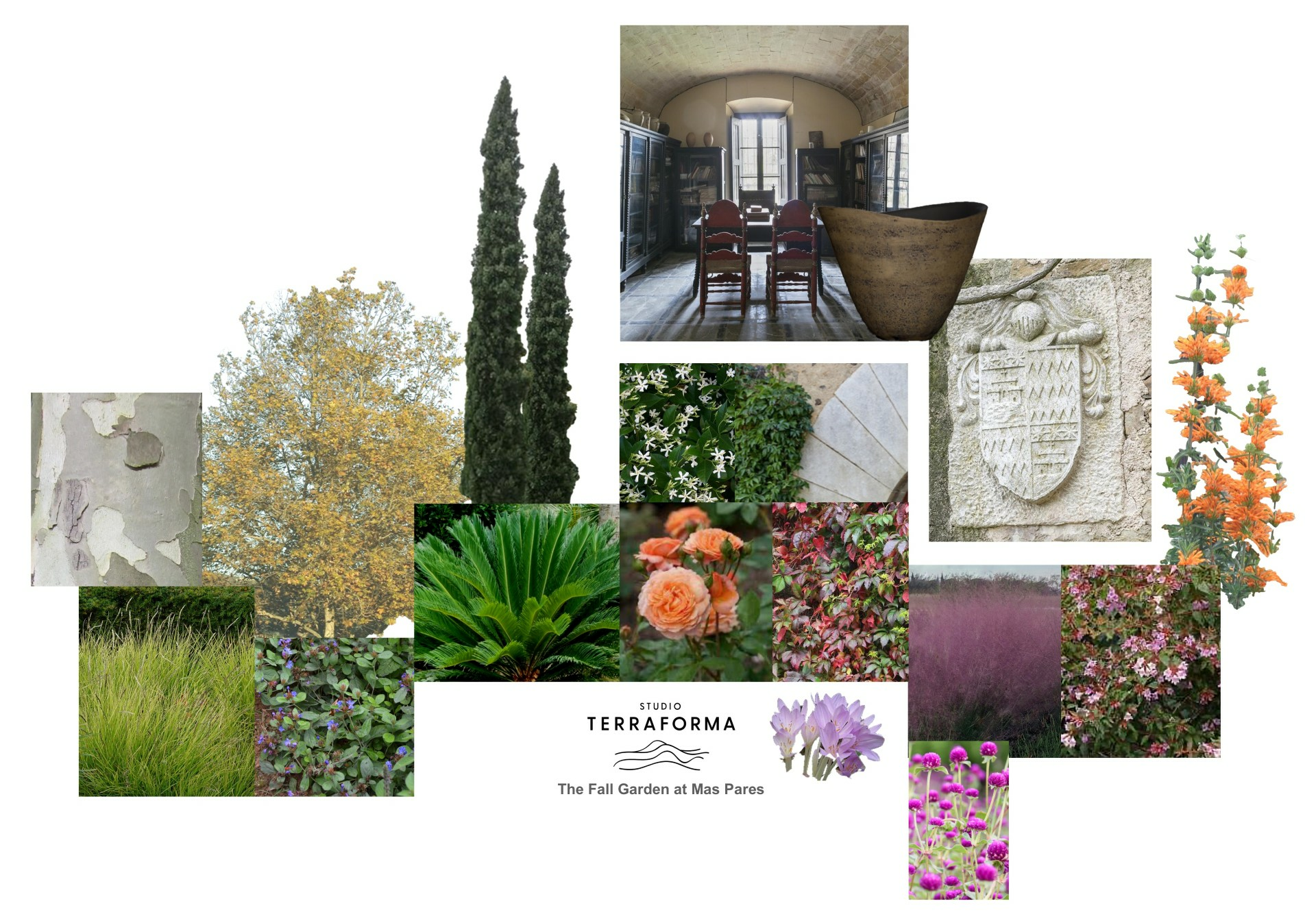
Another climbing vine, Star jasmin (jasmín estrella), is added to the facade and brings out the ceramic inlay of ‘Mas Pares’ while adding fragrance. Next, I added large ceramic dark brown pots from Atelier Vierkant for scale and interest (design tip: it’s important to understand scale of the surrounding when selecting pots). Planted with Sago palms for year round structure and massings of magenta Gomphrena for seasonal impact upon entering the area.
I like the idea of incorporating a curved bench in stone similar to the window surround, then adding a layer of Muhlenbergia capillaris with its beautiful pink blooms swaying in the background. This is balanced on the opposite side with a soft hedge of pink flowering Edward Goucer abelia and fall blooming Leonotis for its orange color, height and interesting flower shape. The three plants create a soft combination of orange, shades of pink and green. Then apricot rose Louise Clements provides fragrance near the door and Colchicum lusitanum bulbs (False autumn crocus) mingle in the paving.
I could also see an interesting herb garden of lavender, rosemary, fruit trees, roses and perennials in the garden area to the left of the soft flowering hedge leading visitors into the area with the distant sound of a water feature.
